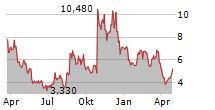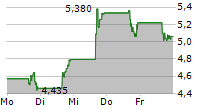
Results from dose escalation arms of Phase 1/2 study of MRT-2359 demonstrated a favorable safety profile and targeted levels of GSPT1 degradation using a 21 days on, 7 days off drug dosing schedule in heavily pretreated solid tumor patients
Recommended Phase 2 dose determined as 0.5 mg daily at a 21 days on, 7 days off drug dosing schedule
Additional MRT-2359 Phase 1/2 study clinical results, including biomarker and activity data, anticipated in Q1 2025
BOSTON, Dec. 05, 2024 (GLOBE NEWSWIRE) -- Monte Rosa Therapeutics, Inc. (Nasdaq: GLUE), a clinical-stage biotechnology company developing novel molecular glue degrader (MGD)-based medicines, today reported an update from its ongoing Phase 1/2 open-label, multicenter study of MRT-2359 in patients with MYC-driven solid tumors. MRT-2359 is an investigational, orally bioavailable, GSPT1-directed MGD discovered and developed by Monte Rosa Therapeutics.
"These latest interim results from our ongoing Phase 1/2 study of MRT-2359 continue to indicate a favorable safety profile, and degradation of GSPT1 to desired levels in patients with heavily pretreated, solid tumors, including those that express high levels of MYC. Importantly, we believe the MRT-2359 safety profile supports further clinical development, with no signs of hypotension, cytokine release syndrome (CRS), or clinically significant hypocalcemia observed at any dose level and regimen, all of which have been reported as safety limitations of other GSPT1 degraders. We're pleased to confirm the selection of 0.5 mg daily at a 21 days on, 7 days off drug dosing schedule as our recommended Phase 2 dose, a schedule that enables dosing of MRT-2359 more than twice as frequently per cycle as compared to the 5 days on, 9 days off regimen previously explored in our study and that we also believe to be more patient compliance-friendly," said Markus Warmuth, M.D., Chief Executive Officer of Monte Rosa Therapeutics. "Trial enrollment has been strong and we are working towards completing the biomarker and activity assessment of our monotherapy dose escalation study using the 21 days on, 7 days off schedule, including backfill cohorts. We have started safety assessments of MRT-2359 in combination with enzalutamide in previously treated metastatic prostate cancer patients as well as with fulvestrant in previously treated metastatic estrogen receptor-positive breast cancer patients. We look forward to providing an update on clinical data from the study as well as plans for potential expansion cohorts in the first quarter of next year."
Summary of Interim Data on Enrollment, Safety & Pharmacodynamics
Enrollment Highlights
- Patients have been dosed with MRT-2359 in 6 dose levels across two dosing schedules, namely a 5 days on, 9 days off drug (5/9) dosing schedule and a 21 days on, 7 days off drug (21/7) dosing schedule.
- The study has enrolled patients with a diverse set of tumor types, including non-small cell lung cancer (NSCLC), small cell lung cancer (SCLC), neuroendocrine (NE) tumors of the prostate, bladder and other organs of origin, androgen receptor-positive prostate cancer, and estrogen receptor-positive breast cancer.
Safety Highlights
- Using the 5/9 dosing schedule, doses of 0.5 mg and 1 mg per day were identified as having a generally favorable safety profile, while doses of 1.5 mg or higher were above the maximum tolerated dose (MTD) with thrombocytopenia being a dose limiting toxicity (DLT).
- Using the 21/7 schedule, both 0.5 and 0.75 mg were identified as having a generally favorable safety profile.
- 0.5 mg using the 21/7 dose schedule was selected as the recommended phase 2 dose (RP2D) for any expansion cohorts of the Phase 1/2 study.
- Safety assessments of MRT-2359 in combination with enzalutamide in previously treated metastatic prostate cancer as well as with fulvestrant in previously treated metastatic estrogen receptor-positive breast cancer have been initiated.
Pharmacodynamic Highlights
- Pharmacodynamic effects were assessed utilizing mass spectrometry measurements of GSPT1 protein levels from paired tumor biopsies. The target levels of approximately 60% GSPT1 degradation were observed in tumor biopsies across all dose levels in relevant tumor types, supporting that the dose of 0.5 mg per day provides optimal degradation consistent with its designed activity based on preclinical studies.
Monte Rosa continues to collect and evaluate clinical results from the MRT-2359 Phase 1/2 study and expects to share updated data, including biomarker and activity data, in Q1 2025.
About MRT-2359
MRT-2359 is a potent, highly selective, and orally bioavailable investigational molecular glue degrader (MGD) that induces the interaction between the E3 ubiquitin ligase component cereblon and the translation termination factor GSPT1, leading to the targeted degradation of GSPT1 protein. The MYC transcription factors (c-MYC, L-MYC and N-MYC) are well-established drivers of human cancers that maintain high levels of protein translation, which is critical for uncontrolled cell proliferation and tumor growth. Preclinical studies have shown this addiction to MYC-induced protein translation creates a dependency on GSPT1. By inducing degradation of GSPT1, MRT-2359 is designed to exploit this vulnerability, disrupting the protein synthesis machinery, leading to anti-tumor activity in MYC-driven tumors.
About Monte Rosa
Monte Rosa Therapeutics is a clinical-stage biotechnology company developing highly selective molecular glue degrader (MGD) medicines for patients living with serious diseases in the areas of oncology, autoimmune and inflammatory diseases, and more. MGDs are small molecule protein degraders that have the potential to treat many diseases that other modalities, including other degraders, cannot. Monte Rosa's QuEEN (Quantitative and Engineered Elimination of Neosubstrates) discovery engine combines AI-guided chemistry, diverse chemical libraries, structural biology, and proteomics to identify degradable protein targets and rationally design MGDs with unprecedented selectivity. The QuEEN discovery engine enables access to a wide-ranging and differentiated target space of well-validated biology across multiple therapeutic areas. Monte Rosa has developed the industry's leading pipeline of MGDs, which spans oncology, autoimmune and inflammatory disease and beyond. Monte Rosa has a global license agreement with Novartis to advance VAV1-directed molecular glue degraders and a strategic collaboration with Roche to discover and develop MGDs against targets in cancer and neurological diseases previously considered impossible to drug. For more information, visit www.monterosatx.com.
Forward-Looking Statements
This communication includes express and implied "forward-looking statements," including forward-looking statements within the meaning of the Private Securities Litigation Reform Act of 1995. Forward-looking statements include all statements that are not historical facts and in some cases, can be identified by terms such as "may," "might," "will," "could," "would," "should," "expect," "intend," "plan," "objective," "anticipate," "believe," "estimate," "predict," "potential," "continue," "ongoing," or the negative of these terms, or other comparable terminology intended to identify statements about the future. Forward-looking statements contained herein include, but are not limited to, statements about our ability to grow our product pipeline and to broaden the scope of clinical development of MRT-2359 across a range of conditions, statements around the Company's QuEENTM discovery engine and the Company's view of its potential to identify degradable protein targets and rationally design MGDs with unprecedented selectivity, statements around the productivity of the QuEEN discovery engine and the potential of the Company's MGDs against a broad spectrum of targets, statements about the advancement and timeline of our preclinical and clinical programs and pipeline, our ongoing clinical development of our GSPT1 degrader referred to as MRT-2359, including our expectations for the nature, efficiency of clinical trial design, significance, and timing for our disclosure of any updated data from our Phase 1/2 clinical trial of MRT-2359 in MYC-driven solid tumors in the first quarter of 2025, the timing of enrollment of potential Phase 2 expansion cohorts in the first quarter of 2025 and around the potential of the recommended Phase 2 dose for MRT-2359 to have a generally favorable safety profile and be more patient compliance friendly, statements around the Company's ability to successfully complete research and further development and commercialization of its drug candidates in current or future indications, including the timing and results of its clinical trials and its ability to conduct and complete clinical trials; expectation that clinical results will support MRT-2359's safety and activity profile; statements around the advancement and application of our pipeline and platform, statements around our ability to capitalize on and potential benefits resulting from our research and translational insights, our expectations of success for our programs, among others. By their nature, these statements are subject to numerous risks and uncertainties, including those risks and uncertainties set forth in our most recent Annual Report on Form 10-K for the year ended December 31, 2023, filed with the U.S. Securities and Exchange Commission on March 14, 2024, and any subsequent filings, that could cause actual results, performance or achievement to differ materially and adversely from those anticipated or implied in the statements. You should not rely upon forward-looking statements as predictions of future events. Although our management believes that the expectations reflected in our statements are reasonable, we cannot guarantee that the future results, performance, or events and circumstances described in the forward-looking statements will be achieved or occur. Recipients are cautioned not to place undue reliance on these forward-looking statements, which speak only as of the date such statements are made and should not be construed as statements of fact. We undertake no obligation to publicly update any forward-looking statements, whether as a result of new information, any future presentations, or otherwise, except as required by applicable law. Certain information contained in these materials and any statements made orally during any presentation of these materials that relate to the materials or are based on studies, publications, surveys and other data obtained from third-party sources and our own internal estimates and research. While we believe these third-party studies, publications, surveys and other data to be reliable as of the date of these materials, we have not independently verified, and make no representations as to the adequacy, fairness, accuracy or completeness of, any information obtained from third-party sources. In addition, no independent source has evaluated the reasonableness or accuracy of our internal estimates or research and no reliance should be made on any information or statements made in these materials relating to or based on such internal estimates and research.
Investors
Andrew Funderburk
ir@monterosatx.com
Media
Cory Tromblee, Scient PR
media@monterosatx.com



